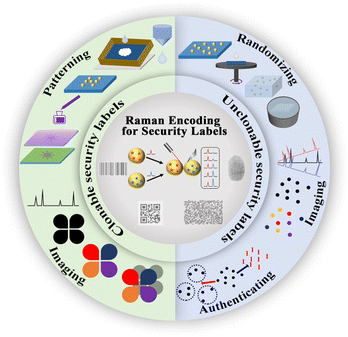 Open Access Article
Open Access ArticleRaman encoding for security labels: a review
Dong
Yu
ab,
Wei
Zhu
*a and
Ai-Guo
Shen
 *ab
*ab
aSchool of Bioengineering and Health, Wuhan Textile University, Wuhan 430220, China. E-mail: weiz@wtu.edu.cn
bCollege of Chemistry and Molecular Sciences, Wuhan University, Wuhan 430072, China. E-mail: agshen@whu.edu.cn
First published on 18th October 2023
Abstract
Owing to its excellent multiplexing ability, high stability, and molecular fingerprint characteristics, Raman encoding has been widely used in security labels for medical safety, jewelry identification and food supervision. Various growing demands have promoted the anti-counterfeiting mode of security labels based on Raman encoding from the classic one that relies on specific patterns to the more secure one that depends on random patterns. As impressive progress has been made in Raman encoding for security labels in recent years, this review attempts to comprehensively cover security labels based on Raman encoding, from label preparation to image verification. For the labels with different anti-counterfeiting modes, the different basic elements they need are summarized, and the role of Raman encoding in different modes is introduced. In addition, security labels based on Raman encoding still have some drawbacks. Therefore, suggestions on how to improve its anti-counterfeiting performance are also discussed, as well as future challenges and prospects.
1 Introduction
The business of counterfeiting is growing worldwide, and involves a wide range of products, from consumer goods to specialized technologies, causing trillion-dollar losses in industry.1,2 In addition to being an economic issue, it also poses a threat to human health and national security.3–7 Therefore, it is urgent to develop a high-security anti-counterfeiting system.In order to combat counterfeit products, their passage through the supply chain must be considered. Since they can enter at any stage of the supply chain, products must be authenticated at multiple stages. In an ideal situation, products can be authenticated at any dispatch and storage point from the manufacturer to the end user.8 To solve this problem, an effective method is to attach security labels on the products that need protection.9
The combination of optical encoding and security labels can greatly improve the security of anti-counterfeiting system.10 Optical encoding, also known as spectral encoding, can be divided into four main types according to the different optical mechanisms: fluorescence, Raman, reflection and luminescence lifetime.11,12 Among them, fluorescence and Raman encoding are dominant because of the relatively simple encoding process and high encoding capacity.12 Fluorescence encoding is popular because of its high brightness and easy readout, while Raman encoding is advantageous because of its narrow bandwidth.13 However, when using conventional fluorescent dyes, there is a limited number of fluorescent agents with the same excitation wavelength, and the overlap of their emission bands greatly limits the number of fluorescence codes available. In Raman encoding, it is possible to obtain different spectra by combining different Raman signal molecules,14 and to create new codes by adjusting the intensity ratio between different characteristic peaks, which can greatly increase the ability of encryption.15 Therefore, Raman encoding will have higher encoding capabilities.16 For the design of security labels, the most important thing is to store security information, higher encoding capabilities means that more types of information can be stored.17 At the same time, its molecular fingerprint characteristics, no interference from water, and high optical stability also make Raman encoding more competitive in security labels. Although there are two reviews focusing on Raman based security labels, the role of Raman encoding has not been explored in the reviews.18,19
According to the anti-counterfeiting modes of security labels based on Raman encoding, the existing security labels can be divided into two categories: the first type is using Raman-active materials to prepare security labels with specific information carrier patterns, which is the combination of Raman encoding and traditional security labels. The encryption method relies not only on the visible pattern, but also on the secret pattern decoded by the Raman-active material hidden inside.20 Owing to the combination of technology, the material of the label has become more complex, so it is harder to forge.21 And due to the similar anti-counterfeiting pattern, the verification of security labels can adopt the verification mode of traditional security labels.
The second type completely overturns the traditional anti-counterfeiting mode that relies on the specific patterns, and randomizes the pattern formation process to generate random patterns, which is called a PUF security label (PUF – Physically Unclonable Function).22,23 A PUF is a physical object with inherent, unique, fingerprint-like characteristics.24,25 When introduced into the security labels, the security label is generated by a random manufacturing process, so that the designer, manufacturer, and producer of the label cannot control it, ensuring the physical non-replicable characteristics of the labels. The random manufacturing process is easier to produce and more unpredictable. Complex patterns have also brought a new way of verification, image authentication, which requires accurate identification of anti-counterfeiting patterns by artificial intelligence.
Based on the above, this paper will introduce the application of Raman encoding in security labels, mainly including two kinds of security labels, one is clonable Raman security labels that rely on specific patterns, and the other is unclonable Raman security labels that rely on random patterns (Fig. 1). Firstly, two important aspects of clonable Raman security labels are introduced: (1) preparation methods of specific patterns, including printing, writing, lithography, self-assembly, etc.; (2) image acquisition modes, including zero-dimensional image-Raman spectrum, monochrome image, multicolor image, super-multicolor image, and multi-layer image. Then three important aspects of unclonable Raman security labels are introduced. (1) Preparation methods of random patterns, including spin-coating, adsorbing, doping, and annealing; (2) random image acquisition modes, including monochrome random image, multi-color random image and multi-layer random image; (3) authentication methods for random images, including “point-to-point” authentication after digitization and feature recognition authentication.
2 Raman encoding for traditional security labels
By combining Raman-active materials with traditional security labels, the labels with Raman scattering characteristics can be prepared, and Raman encoding can bring a higher security. In the traditional anti-counterfeiting system, the generation of a specific pattern with security information stored and the identification of the corresponding image are two important components. In the following part, the preparation technology and verification method of clonable Raman security labels will be introduced.2.1 First element of clonable Raman security labels: patterning
The security of clonable Raman security labels mostly depends on the specific patterns of the labels, such as trademarks, patterns, and the two-dimensional code or barcode with information storage function, etc., through the discrimination of these patterns to achieve anti-counterfeiting.26,27 Therefore, in the anti-counterfeiting system of clonable Raman security labels, the method of pattern formation, which can be called “patterning”, is crucial.Inkjet printing is a non-contact printing method without a printing plate. Through controlling the movement of the nozzle, the tiny ink drops are sprayed on the substrate under the control of the program, forming the same image as the design pattern. Inkjet printing as a patterning technology has been widely used in the preparation of other security labels,29 but few people have developed in the field of clonable Raman security labels. Researchers pay more attention to the preparation of surface-enhanced substrates with specific detection areas. For example, Yang et al. used inkjet printing to prepare a surface-enhanced active point array composed of uniformly distributed and closely aligned gold nanoparticles (Au NPs) directly on the hydrophobic substrate, which was used for rapid and large-scale quantitative analysis in chemical detection and biological diagnosis.31 Li et al. developed an inkjet printing ink based on silver nanoparticles (Ag NPs) functionalized by aryl diazonium salts, which were then inkjet printed on a polyethylene naphthalate substrate.32 The successful implementation of these cases effectively proves the combination of inkjet printing and Raman-active materials, thanks to the excellent ink compatibility of inkjet printing. And with the development of material synthesis technology, Raman-active materials have become more adaptable to a variety of application environments.
Another commonly used printing technique is screen printing. Screen printing has the advantages of simple equipment, easy operation, fast plate making, and low cost. The requirements for ink properties will be more lenient, and more materials can be chosen. This printing method has also been widely used in the patterning of other security labels, such as in fluorescent anti-counterfeiting. Li et al. combined an upconversion fluorescent material and carbon quantum dots to prepare screen printing ink, and printed it as two-dimensional code, the logo of Wuhan University, and other patterns used for anti-counterfeiting.33 The patterning of Raman-active materials has also been reported. Qu et al. used screen printing to accurately print Au NPs and Ag NPs into microfluidic detection areas with dumbbell shapes. It is proved that screen printing has the patterning function on Raman-active materials with easier operation.34
As an important tool for writing and painting, the pen can be a production tool for anti-counterfeiting patterns. At present, there are many reports about the preparation of clonable Raman security labels based on pen writing. For example, Zhou et al. developed a Raman anti-counterfeiting system by designing a signature ink based on an Au@Ag aggregate, and successfully combined this system with a mobile phone app.35 Gu et al. used Raman ink for steganography, and simply mixed Raman-active materials into commercial pen inks to obtain security inks for steganography.36 The inks have the same writing color but different Raman signal outputs (Fig. 2A). These methods make writing a more convenient and simple patterning method, which is a worthwhile method for the production of patterns that do not require mass production and precise production.
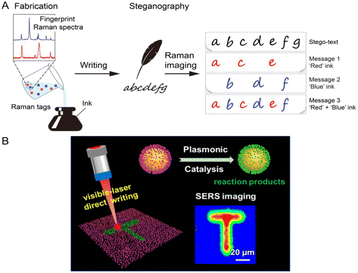 | ||
| Fig. 2 The patterning process of writing. (A) Pen writing. Reproduced with permission from ref. 36. Copyright 2021 John Wiley & Sons, Inc. (B) Laser writing. Reproduced with permission from ref. 37. Copyright 2021 American Chemical Society. | ||
Another type of technology related to writing is laser writing. It has been found that lasers can induce catalytic reactions on plasmonic nanomaterials with Localized Surface Plasmon Resonance (LSPR). On this basis, Zhang et al. prepared self-assembled single-layer Au NPs as security labels for laser writing (Fig. 2B). They modified p-aminothiophenol on the surface of Au NPs and catalyzed p-aminothiophenol molecules to form azobenzene structures through high-energy laser irradiation. As the laser path changes to form the desired pattern, the reaction can also be further reversed by adding the reducing agent sodium borohydride.37 With lasers as a “pen”, nanoparticles with plasmon catalytic activity and molecules with Raman activity as “ink”, this technology is more complex and the instrument is more expensive.
Lithography is one of the most widely used micro-patterning techniques because of its high stability and the ability to prepare samples on a large scale.38 And the resolution of lithography is gradually increased from the micron level to the nanometer level with the development of new radiation sources and new optical devices.39–41 The emergence of higher resolution lithography technology has also provided strong support for the preparation of SERS security labels. Liu et al. used two-photon lithography to produce silver nanowires with Raman information storage and arrange them into English letters and Tai Chi patterns.42 Subsequently, the research group further applied the two-photon lithography technology, expanded the range of applicable materials, and designed a more detailed pattern.43 The mixed resin of the photoresist and probe molecules was irradiated by a laser to form nano-columns, and then coated by an Ag layer (Fig. 3A). The use of lithography technology makes the security labels prepared by it tend to be miniaturized. Although this reduces the pressure for Raman imaging of anti-counterfeiting patterns, smaller labels mean that more sophisticated preparation instruments and more accurate verification processes are required.
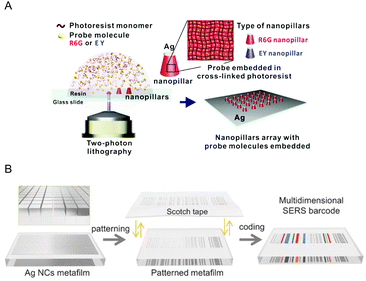 | ||
| Fig. 3 Process of nanostructure patterning. (A) Lithography. Reproduced with permission from ref. 43. Copyright 2016 Royal Society of Chemistry. (B) Self-assembly. Reproduced with permission from ref. 44. Copyright 2016 John Wiley & Sons, Inc. | ||
As another common nanostructure patterning technology, self-assembly technology overcomes the shortcomings of high cost and low throughput of lithography. Self-assembly technology is a technology that uses physical or chemical adsorption to arrange nanoparticles into patterns. And self-assembly does not require special instruments and can be relatively simple for preparing large-area patterns (generally down to the micron scale). Li et al. prepared a single-layer silver nanocube through liquid–liquid interface self-assembly in advance.44 Then the tape with a template is used to remove the excess nanostructures and prepare them into barcodes (Fig. 3B). However, compared with the lithography, the stability of the preparation process is difficult to be guaranteed.
As a result, a new method has emerged that combines lithography and self-assembly to achieve patterning. Zhang et al. first used the self-assembly method of LB film (Langmuir–Blodgett nanoparticle assembly) to arrange silver nanoparticles neatly into a single layer structure, and then changed the flat nanostructure to a three-dimensional structure through lithography.45 In this work, the periodic nanostructures are neatly arranged by self-assembly, which greatly reduces the work time required by lithography. The combination of the two technologies complements each other's advantages and disadvantages, making the patterning process achieve a balance in manufacturing efficiency and accuracy.
2.2 Second element of clonable Raman security labels: imaging
For clonable Raman security labels, it is very necessary to verify the pattern after completing the preparation process. As products move through the supply chain, every owner who wants to ensure that the goods are high-quality products has the need. For clonable Raman security labels, the true anti-counterfeiting pattern is “hidden” and a special “decoding” process is required to complete the verification. This special “decoding” process is image acquisition, which is called Raman imaging. In Raman imaging, regions with the same Raman shift will be marked with the same color, and vice versa (regions with different Raman shifts will be marked with different colors). For regions with the same Raman shift but different intensities the intensity will be represented by the depth of the same color. And in the case of two shift encoding, this intensity (proportion) distinction will also appear in the form of different colors. Therefore, Raman encoding will make the image more “colorful”.In this paper, the collected images are classified according to the used Raman encoding. The first type uses a single Raman signal as the output, through the position encoding to complete the imaging of specific patterns, including linear encoding, barcode, two-dimensional code, and three-dimensional encoding. The anti-counterfeiting system using a single Raman spectrum for security identification is also included, as a zero-dimensional encoding; the second type is to combine two or more kinds of Raman signals to complete the Raman shift encoding, further increasing the color to obtain a multicolor image; the third type is not only focused on the Raman shift encoding, but also takes the corresponding Raman peak intensity into consideration, making the obtained image more colorful. In order to distinguish it from the second type, we call it a super-multicolor image. The fourth type combines Raman encoding with other optical encoding to complete the construction of multi-layer images, which can greatly improve the complexity and security of the anti-counterfeiting system.
In clonable Raman security labels, some researchers will simply use a Raman spectrum rather than specific Raman images for security applications.46–48 In this paper, the method is classified into zero-dimensional position encoding. Raman spectroscopy, as a non-invasive analysis method with high accuracy, is often used to identify the authenticity of goods. On the one hand, it can use the difference of the material composition between the real and fake goods, directly reflected in the Raman spectrum. Poppi et al. used Raman spectroscopy to identify banknotes. They found that the aluminum ink on the “fake” banknotes showed a strong Raman peak, which was the result of phthalocyanine pigments, while the Raman spectrum of the genuine aluminum ink showed not only phthalocyanine pigments, but also the presence of diaryllactone pigments.49 On the other hand, Raman-active molecules can be introduced as indicators to distinguish the authenticity of products, and products with a specific Raman spectrum are genuine. Basit et al. designed a personalized drug label with Raman anti-counterfeiting features. The authors used inkjet printing to add four points containing Raman active inks to the original label. By measuring the Raman spectra of these active points separately, the authenticity of the ink material and the drug is determined.50 The application process simplifies the entire Raman anti-counterfeiting system, using a single point of information to directly judge the anti-counterfeiting system, and the production method will be simpler. But the security of the system is low because of the security information provided by only a single Raman spectrum.
On the basis of zero-dimensional position encoding, one-dimensional position encoding can be performed by arranging Raman-active basic units on a linear structure. Among many carriers, strip nanostructures have received extensive attention.51 This is because the nanoscale size allows them to be integrated into many materials without materially changing their properties. And they are easy to customize, showing promise for commercial applications. Banholzer et al. developed a nanodisk code based on gold and silver bar nanostructures, which stores information about Raman enhancement at the junction of each structure. The number of encodings in this way also varies with the length of the component segment.52 However, this fine nanostructure preparation is a challenge, so the use of encoding will be relatively complicated.
Furthermore, the encoding mode can be extended from a one-dimensional linear structure to a two-dimensional image, which is the most commonly used image in anti-counterfeiting, such as barcodes and QR codes. For barcodes and QR codes in Raman encoding, the distinction between the black and white area is determined by the presence or absence of Raman signals.
In a particular example, a single Raman spectrum can be converted into a barcode. Feng et al. used silica coated gold nanoparticles (Au@SiO2 NPs) as the encoding unit to realize the combined output of different Raman spectra by electrospinning, located the position of the black blank according to the position of the Raman peak, and determined the width of the blank by the strength of the Raman peak.53 This anti-counterfeiting mode simplifies the output of information, so that it can be read by the smart phone directly. At the same time, the existence of this transcoding rule will further increase the difficulty of cracking and confuse the forger.
Compared with barcodes, QR codes have a higher storage capacity, which creates an opportunity for polarized light. Lay et al. reported an aluminum-based nanostructure with a polarization-dependent SERS response and used it to fabricate miniature QR codes.54 The images obtained through the SERS imaging of X polarization were two-dimensional codes, which could directly guide users to the website with school information recorded, while the SERS images of Y polarization stored secret information (Fig. 4). The simultaneous existence of multiple pieces of information makes the anti-counterfeiting system more reliable and more difficult to be breached.
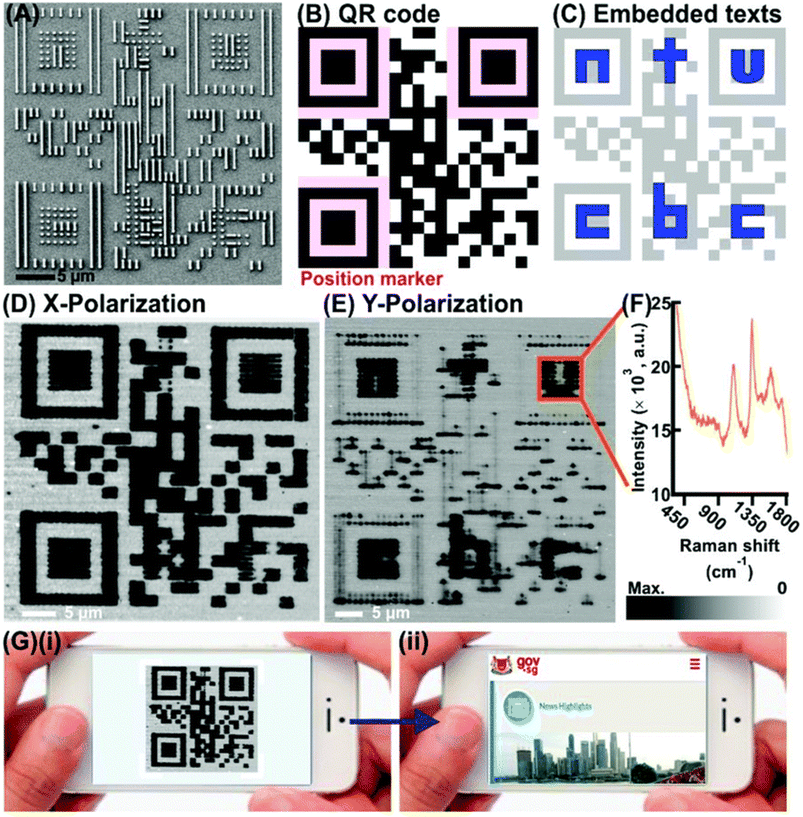 | ||
| Fig. 4 Polarization-dependent miniature two-dimensional code for security labels. (A) Scanning electron microscopy (SEM) of the QR code; (B) QR code with school information; (C) embedded cryptographic text; (D) Raman imaging under X-axis polarized light; (E) Raman imaging under Y-axis polarized light; (F) Raman spectrum in the red box in (E); (G) scanning the QR code to obtain the school website information. Reproduced with permission from ref. 54. Copyright 2018 Royal Society of Chemistry. | ||
In more cases, researchers will design other two-dimensional images with special significance, such as initial letters, school badges, and so on. Guan et al. used in situ chemical patterning technology to prepare pattern-controlled arrays. Through SERS imaging, the letter patterns were accurately obtained on the PDMS substrate in the range from macroscopic to submicroscopic.55 The use of this special two-dimensional image plays a similar role to the effect of a trademark, indicating the manufacturer's message.
By adding the encoded signal of the Z-axis, the security label can be extended from two-dimensional to three-dimensional. Liu et al. constructed a plasmonic candlestick microstructure for use in security labels.56 The Raman signal can only be collected at the top of the candlestick microstructure. Therefore, different safety patterns can be collected at different Z-axis heights by designing the candlestick microstructure of different heights (Fig. 5). The addition of Z-axis space greatly expands the space available for encoding. However, due to the penetration of the laser in the acquisition process, the acquisition plane must be strictly fixed to ensure that the acquisition is carried out at a certain position. And during pattern design, signals between different layers should not interfere with each other.
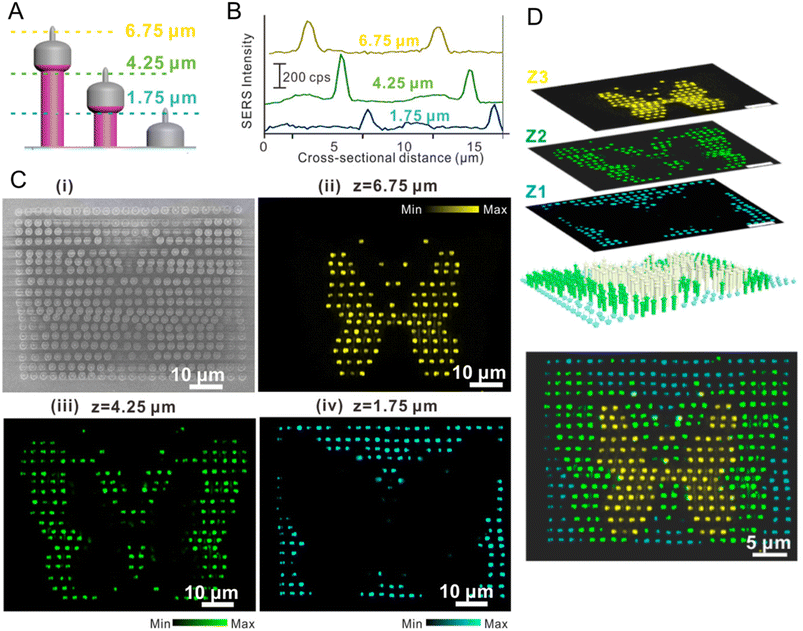 | ||
| Fig. 5 Three-dimensional micro-candlestick for a security label. (A) Schematic diagram of the three-dimensional micro-candlestick; (B) corresponding Raman spectra; (C) scanning electron microscopy (SEM) images and Raman imaging images of different heights of the three-dimensional micro-candlestick; (D) schematic diagram of the three-dimensional micro-candlestick forming patterns at different scan heights. Reproduced with permission from ref. 56. Copyright 2017 American Chemical Society. | ||
In the monochrome image, the encoding space increases with the dimensions. It is assumed that each dimension has the same number of encoding units. If a one-dimensional pattern has n encoding units, then a two-dimensional pattern has n2 encoding units, and so on. Therefore, the increase of dimension brings more choices to the design of the pattern. With the increase of encoding space, the image will be more complex and carry more information, making it more difficult to break.
Raman shift encoding has been widely used in multicolor anti-counterfeiting images. Generally speaking, in the multicolor image of Raman anti-counterfeiting, it is impossible to obtain a complete anti-counterfeiting image by only a single shift Raman signal imaging. For example, Gu et al. wrote different parts of alphabetic information with different Raman inks.36 Using “red” Raman ink to write the information “a, c, e” and using “blue” Raman ink to write the information “b, d, f”, the two kinds of information together can present the complete letter information from “a” to “f”. In another case, the overall multicolor image is meaningless, and the corresponding monochromatic image of each signal output is combined into a meaningful message. Liu et al. prepared a 5 × 5 size grid array on a flexible substrate, forming an overprint pattern of the initials of Zhejiang University (ZJU) by depositing three different organic dyes, Rhodamine B (RB), malachite green (MG), and crystal violet (CV), on a specific grid.57 Among them, the letters “Z”, “J” and “U” can be obtained by the characteristic peak imaging of RB, MG, and CV respectively, and the images based on the combination of the three are meaningless (Fig. 6A). In applications with more Raman-active materials, researchers have chosen to store information in a single point of the Raman spectrum to avoid the complexity of designing patterns and precise patterning (Fig. 6B–E). Because there are enough encoding combinations, the difference in spectral characteristics can be used to achieve safe identification.35,58
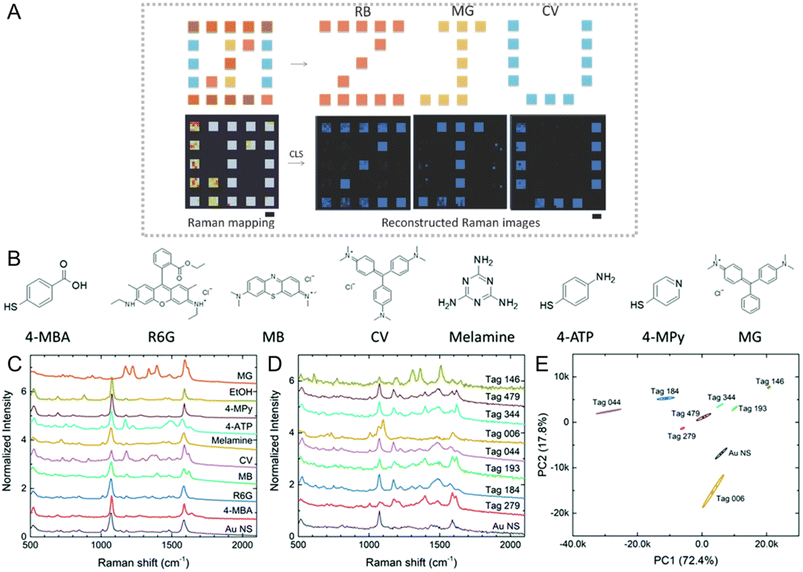 | ||
| Fig. 6 Raman shift encoding for security labels. (A) Adsorbing different dye molecules to different regions of the array and conducting Raman imaging to obtain complete information of “Z”, “J” and “U”. Reproduced with permission from ref. 57. Copyright 2016 John Wiley & Sons, Inc. (B) The eight probe molecules used in encoding; (C) Raman spectra corresponding to the probe molecule; (D) Raman spectra of security labels composed of different probe molecules; (E) principal component analysis diagram of eight security labels. Reproduced with permission from ref. 58. Copyright 2021 Royal Society of Chemistry. | ||
Under the premise of having the same encoding space, the increase of color will further increase the complexity of the image, making it more difficult to forge the security information. The increase of color depends on the type of signal molecules, so ensuring that there are enough clearly distinguishable signal molecules is critical. Another thing to which attention should be paid is the patterning method. In most cases, it will be simpler by choosing adsorption first and then patterning. The multicolor anti-counterfeiting image can be constructed by patterning the encoding units with different colors according to their respective arrangement.
For clonable Raman security labels with intensity encoding, Li et al. used four different signal molecules and divided the characteristic peak strength of each signal molecule into four levels of “0”, “1”, “2” and “3” to achieve the output of barcodes with multiple colors (Fig. 7). In the barcode, regions with the same signal molecules but different signal strengths are given different colors, representing different information.44 For the Raman spectral information, intensity encoding has a higher utilization, so it can transmit more information. However, this high-precision spectral data recognition capability has not yet been popularized in commercialized software, it is necessary to complete the imaging of the pattern after the processing of the data.
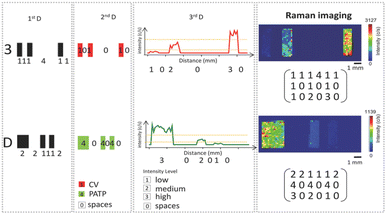 | ||
| Fig. 7 Intensity encoding for the Raman security label. The information “3D” is stored in the Raman QR code. Reproduced with permission from ref. 44. Copyright 2016 John Wiley & Sons, Inc. | ||
For clonable Raman security labels, intensity encoding can further increase the color of the anti-counterfeiting image on the basis of the previous shift encoding, so this image can be called a super multicolor pattern. Under the premise of using the same signal molecules, intensity encoding technology can distinguish the encoding unit twice, so as to distinguish more colors. In theory, the number of intensity encodes is unlimited, but in practice, it is difficult to maintain Raman signals to a constant signal ratio. Therefore, the intensity ratio in a certain range is regarded as the same color to prevent misidentification due to signal fluctuations.
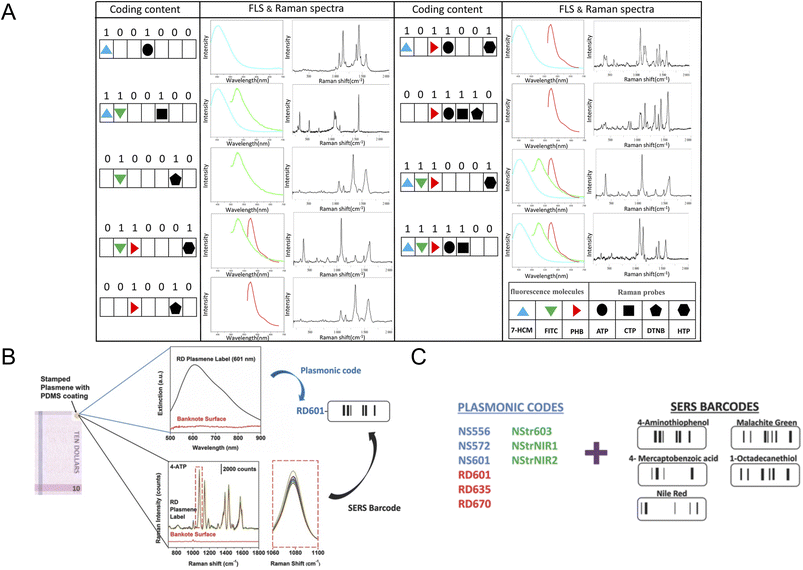 | ||
| Fig. 8 (A) Raman–fluorescence combined encoding for security labels; Raman–absorption combined encoding for security labels. Reproduced with permission from ref. 60. Copyright 2016 American Chemical Society. (B) Schematic diagram of the encoding source; (C) double layer encoding – plasmonic encoding and Raman encoding. Reproduced with permission from ref. 61. Copyright 2015 John Wiley & Sons, Inc. | ||
Since most Raman applications rely on noble metal nanomaterials, it is also possible to achieve combination encoding with the properties of nanomaterials. Since the LSPR characteristics of noble metal nanomaterials are closely dependent on the size and shape, the nanomaterials with different shapes and sizes will produce different characteristic absorption spectra. Cheng et al. made use of this property to synthesize nanoparticles with different sizes of three morphologies, including spherical, dodecahedral and star shapes.61 These different nanoparticles can be well distinguished by absorption spectra, and the output of Raman signal molecules adsorbed on them can be combined to form barcodes with specific numbers. Thus, large-capacity and specific recognition is achieved (Fig. 8B and C). This method can theoretically change the signal of nanoparticles infinitely, but because the peak of the absorption spectrum is wide and easy to overlap, it is difficult to distinguish clearly when a variety of nanoparticles appear.
2.3 Summary
In general, the use of Raman encoding makes the anti-counterfeiting image more complex, and improves the anti-counterfeiting strength. By converting the Raman spectral information into the information required by the anti-counterfeiting image, such as the position and the color, the anti-counterfeiting image can be reproduced. After that, the traditional verification mode can be used directly to verify the produced clonable Raman security labels.3 Raman encoding for PUF security labels
The concept of PUF originated in cryptography and was proposed in 2002 as a physical one-way function.20 Such one-way functions are used for security information sharing, they are easy to build but difficult to obtain again, ensuring the uniqueness of this password. Subsequently, PUFs were extended to physical objects with unique fingerprint-like characteristics. Their uniqueness is generated by the random disorder of the microstructure in the manufacturing process of the object, they are easy to produce but impossible to copy, easy to read but impossible to predict.9 Because they have a high encoding ability, the unclonable feature makes it unnecessary to keep the information of the tag secret, and they only rely on the uniqueness of their physical characteristics for anti-counterfeiting. The uniqueness of this physical feature can often be combined with chemical methods,22,62–64 using different markers and detection methods to increase its encoding ability, such as Raman-active materials.Unlike traditional security labels that rely on specific anti-counterfeiting patterns, PUF security labels increase the complexity by generating random anti-counterfeiting patterns. In the unclonable Raman security labels, the security label is composed of randomly distributed encoding units with Raman activity. Before the corresponding anti-counterfeiting pattern is read by Raman spectroscopy, the resulting pattern cannot be determined due to the unpredictable position of the encoding unit. Once the obtained anti-counterfeiting pattern is read out, only this one security label can get the same anti-counterfeiting pattern. With a large enough encoding capacity, it is difficult to generate security labels with the same characteristics. For unclonable Raman security labels, the role of preparation is to make the encoding units randomly distribute, and randomize the Raman imaging patterns obtained through image acquisition. And due to the complexity of random patterns, unclonable Raman security labels also need to pass image authentication to complete the identification and verification of anti-counterfeiting patterns.
3.1 First element of unclonable Raman security labels: randomizing
Compared with the process of Raman security labels, PUF security labels are there to cause disorder and randomize the encoding unit, and this process will be relatively easier to operate due to the tendency towards disorder. In the randomizing process, many physical processes are used to produce disordered Raman-active materials, forming random anti-counterfeiting patterns.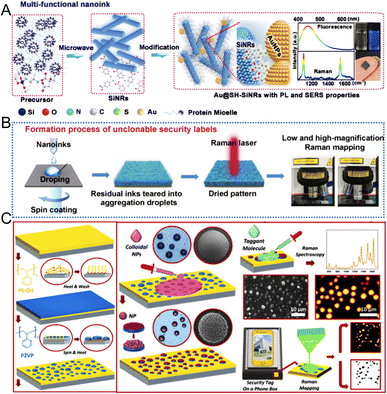 | ||
| Fig. 9 (A) Schematic diagram of the preparation of multifunctional nanoparticles; (B) schematic diagram of spin-coating for the preparation of PUF security labels. Reproduced with permission from ref. 66. Copyright 2021 Elsevier. (C) Schematic diagram of adsorbed nanoparticles after the preparation of random micro-regions using dry instability. Reproduced with permission from ref. 68. Copyright 2021 American Chemical Society. | ||
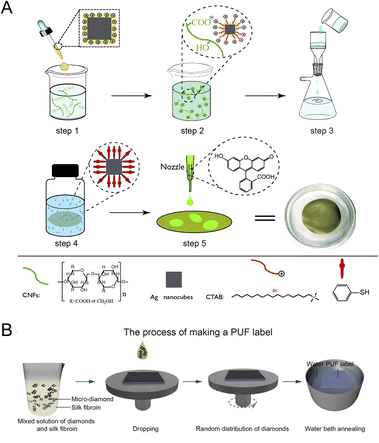 | ||
| Fig. 10 (A) Schematic diagram of the random distribution of active materials formed by doping. Reproduced with permission from ref. 72. Copyright 2020 Royal Society of Chemistry. (B) Schematic diagram of the random distribution of micron diamonds formed by annealing. Reproduced with permission from ref. 67. Copyright 2021 John Wiley & Sons, Inc. | ||
3.2 Second element of unclonable Raman security labels: imaging
In the image acquisition of unclonable Raman security labels, due to the random distribution of Raman-active materials, the acquired images are randomly generated patterns in the encoding space. The essence of the random distribution is random position encoding, which can make full use of encoding space. In theory, in a certain encoding space, the active materials may be distributed at any point, so a large number of anti-counterfeiting images can be generated. Enough anti-counterfeiting images may make it impossible to get the same anti-counterfeiting image in a limited number of copies, thereby eliminating the possibility of forgery. This number of possible anti-counterfeiting images, or the number of labels, is called the encoding capacity. The encoding capacity of a PUF security label can be defined as the product of the number of responses (R) that a security image pixel can have and the number of security image pixels (n) (encoding capacity = Rn).75 If the encoding capacity is too low, the PUF security label can be cracked by trying all possible combinations. For unclonable Raman security labels, the type of output that Raman-active materials can carry determines the final encoding capacity.In a zero-dimensional space, the encoding capacity depends only on the number of possible spectra.73,74 However, due to the high similarity in the peak position of these Raman spectra, the encoding capacity brought by the random features is relatively limited, and is easily affected by the acquisition conditions. How to accurately locate the collection point on the same point of the security label is also a challenge, which will affect the repeated verification of the label.
In two-dimensional space, the generated Raman-active materials can exist at any point in two-dimensional space, resulting in a random two-dimensional image. In this case, the encoding capacity of the label can be calculated by the formula, since in a monochrome image the number of responses is 2, so the encoding capacity is determined by the number of encoding units present in the image. Hu et al. used micron diamond as Raman-active materials to generate unclonable Raman security labels with 2100 encoding capacity within 100 encoding units (Fig. 11).67 Therefore, in the same encoding space, having a smaller encoding unit will improve the encoding capacity.
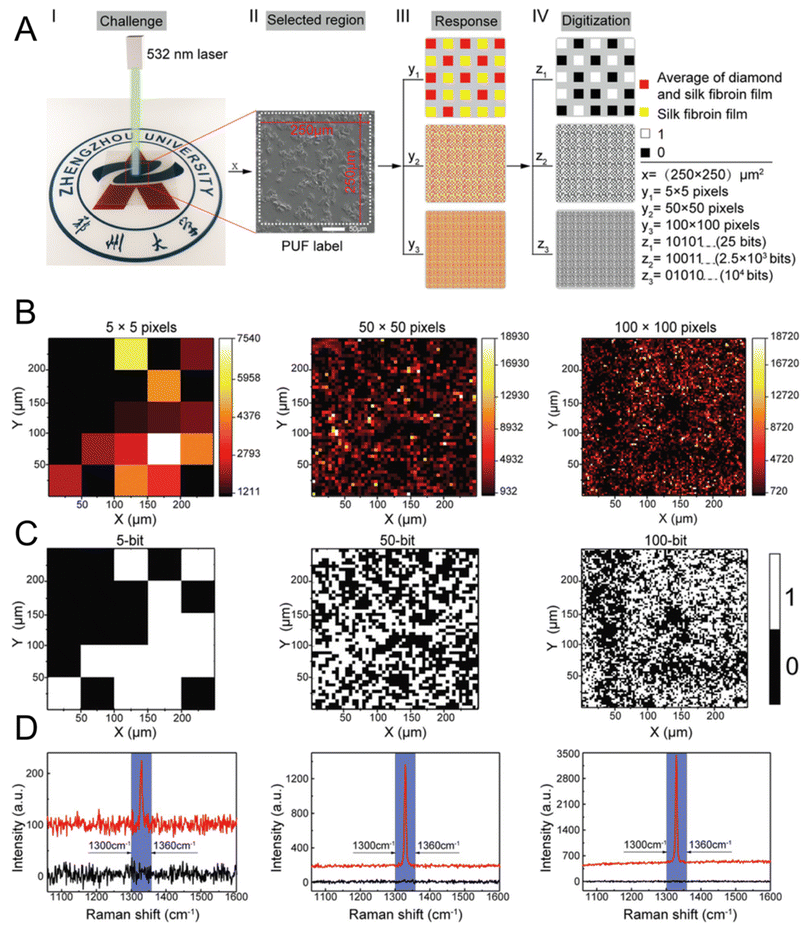 | ||
| Fig. 11 (A) Schematic diagram of encoding the PUF label; (B) Raman imaging of the PUF label; (C) the binary-encoded map corresponding to the image; (D) corresponding binary Raman spectrogram. Reproduced with permission from ref. 67. Copyright 2021 John Wiley & Sons, Inc. | ||
Different from Raman security labels, which use the combination of shift and intensity encoding, this encoding mode rarely appears in unclonable Raman security labels. In the only example, Gu et al. completed the intensity and shift encoding of ten Raman signals in PUF security labels with ten different Raman-active nanoparticles (Fig. 12).65 However, this encoding is not completed in a single anti-counterfeiting image, but forms ten anti-counterfeiting images from a single label. Due to the random distribution characteristics of Raman-active particles, the number of possible combinations is large, and it is necessary to accurately distinguish them by AI. There is no doubt that the encoding strategy of this combination can greatly increase the encoding capacity of PUF security labels.
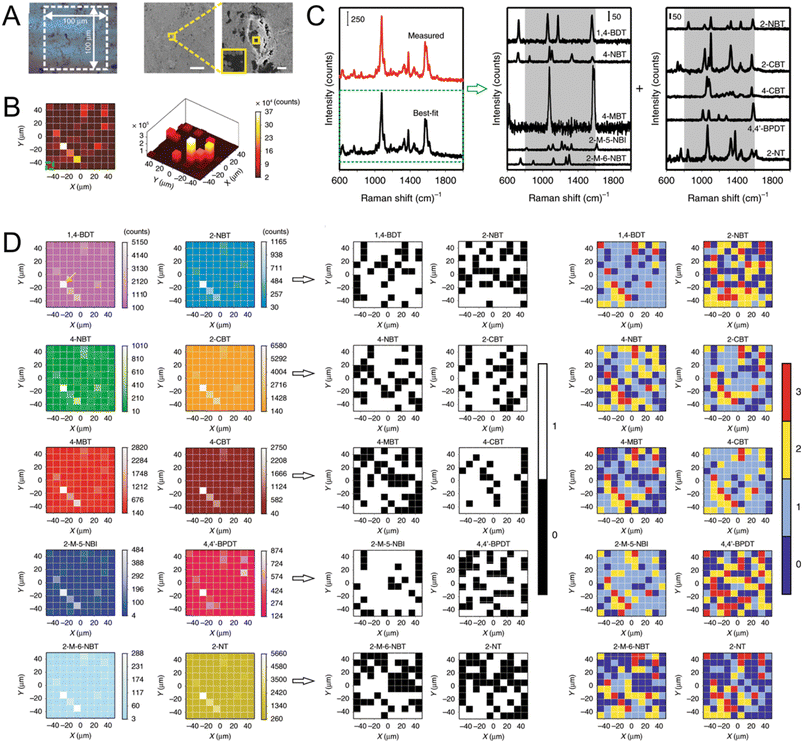 | ||
| Fig. 12 (A) Picture and scanning electron microscope images corresponding to the label; (B) corresponding 2D and 3D Raman imaging images; (C) the Raman spectra corresponding to the green box in (B) and the Raman spectra after the signal is divided into ten signals of the molecules; (D) Raman imaging images, binary images and quaternary images corresponding to ten signal molecules. Reproduced with permission from ref. 65. Copyright 2020 Springer Nature. | ||
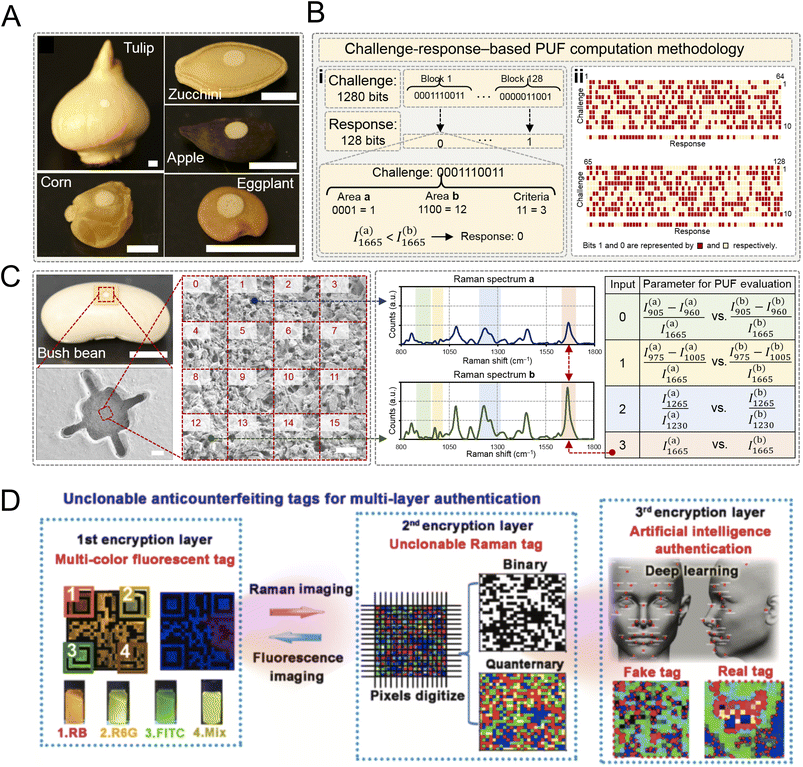 | ||
| Fig. 13 (A) Schematic diagram of PUF security labels on the surface of different plant seeds; (B) encoding diagram of the PUF security label; (C) schematic diagram of white light and Raman encoding principle. Reproduced with permission from ref. 71. Copyright 2021 Science Publishing Group. (D) Schematic diagram of PUF security labels encoded by Raman and fluorescence. Reproduced with permission from ref. 64. Copyright 2021 Elsevier. | ||
After modifying Au NPs on the surface of silicon nanorods, the active nanoparticle with fluorescence and Raman signals can be obtained.66 Wang et al. used this double-optically active particle to construct two layers of security labels at the same time, using fluorescent labels in the first layer and non-reproducible Raman labels in the second layer (Fig. 13D). In the first layer of the label, its luminous color can be determined by the type of dye molecule on the modification, and a variety of colors can be adjusted, further increasing the encoding capacity. Because the substrate generated by the Raman signal is different from that generated by the fluorescence signal, the random features in the two images are completely different, which realizes the independence of the two encoding modes and can be superimposed in encoding capacity.
3.3 Third element of unclonable Raman security labels: authenticating
Due to the randomness of the PUF security label, the image generated is not fixed and cannot be simply judged by experience. Therefore, further image verification is needed.76–82 Machine learning is used to help identify the correct anti-counterfeiting image. Generally speaking, machine learning is used to compare the acquired images with the anti-counterfeiting images in the database to judge the “true” and “false”. The images with high similarity are “true”, and the images with low similarity are “false”. Because the security image features in different PUF systems are almost completely different, for a specific system, it is necessary to have its matching image verification system. Through the different recognition methods, the recognition methods can be simply divided into two categories, “point by point” comparison and feature recognition.“Point by point” comparison is to compare the numbers bit by bit after digitizing the anti-counterfeiting images, and define the difference size of the comparison median value as similarity. Gu et al. completed the verification of unclonable Raman security labels by point-by-point comparison, and the similarity between “true” and “false” is large and easy to distinguish.65 Feature recognition is to extract the image features of the security image for verification. In comparison, the similarity value can be obtained only by comparing the extracted features. In general, the point-by-point comparison method will obtain faster read speed and lower positive rate, and it is easier to obtain the read advantage under low encoding capacity. Every time a new label was added to the security image library, the model needs to be retrained to maintain its accuracy.
4. Challenges and prospects
Despite the excellent information extension capability of Raman encoding, there are no Raman security labels for practical applications. In order to make the security label develop from a laboratory research to a practical anti-counterfeiting technology, the future focus should be placed on improving verification speed, reducing costs, and facilitating field applications, and further increasing the encoding dimension to increase encoding capacity is still an important topic. In this section, we will focus on these issues by discussing practical approaches and future prospects for optimizing security labels based on Raman encoding.4.1 Improving verification speed
For the verification of Raman security labels, limited by the imaging mode, the images need to be excited by the laser point by point before they can be displayed in the terminal. This time-consuming imaging method will limit the popularity of Raman security labels. In addition to creating instruments with faster scanning speeds, such as imaging with line scanning, the verification time can also be reduced by making a more “delicate” pattern.4.2 Reducing costs
In most application scenarios, expensive noble metal materials are necessary as signal amplifiers for Raman security labels. Therefore, the cost of security labels will be relatively high. Non-metal materials are a great substitute, such as polymers, hydrogels, and inorganics. Since the concentration of the Raman-active materials in the security label can be quite high, there is no need to worry about the signal output strength.4.3 Improving stability
The Raman-active material is always composed of Raman signal molecules and the corresponding carrier, and the molecules easily fall off in the longer-term use process. Therefore, appropriate packaging is necessary, such as the core–shell structure. Also, the use of optically transparent protective layers can alleviate this problem and block out the interference from backgrounds.83,844.4 Increasing the encoding dimension
For Raman encoding, searching for encoding patterns with more dimensions has always been a research hotspot. More encoding dimensions mean that more security information can be placed, or the same security information can be accomplished with less variety of information materials. This is a great help in improving security and reducing synthesis complexity. At present, encoding based on different spatial dimensions has been reported, and perhaps Raman encoding based on the time dimension will be the next emerging encoding.4.5 Improving information utilization
Compared with other security labels that do not use the instrument as verification means, the final output verification image of Raman encoding greatly reduces the collected information. Only a single or several spectral peaks are used to output anti-counterfeiting images, losing most of the collected information. The information capacity in a single spectrum is actually huge. Therefore, how to make full use of these abandoned spaces may be an important direction in the future. These spaces can be occupied by markers that indicate the quality of the product, monitoring the quality of the product while preventing it from being forged.5. Conclusion
Compared with other anti-counterfeiting systems, security labels based on Raman encoding have many unique advantages, including high acquisition stability, excellent multiplexing capability, and so on. At the same time, the diversity of Raman-active materials, from traditional noble metal probes and signal molecules to polymers, hydrogels, and semiconductors, provides flexible options for a variety of applications. And the combination of AI and an anti-counterfeiting system can improve the encoding capacity and the decoding accuracy, which make the system more secure and convenient. So far, researchers have tried to use Raman security labels for practical applications. However, these security labels have not yet gone to commercialization. Looking forward to the future, it is of great significance to develop low cost, high complexity, and universal Raman security labels for information security.Conflicts of interest
There are no conflicts to declare.Acknowledgements
This work was financially supported by the National Natural Science Foundation of China (No. 22304137, 21874102, 21775114 and 22074109).Notes and references
- T. Staake, F. Thiesse and E. Fleisch, Eur. J. Mark., 2009, 43, 320 CrossRef.
- L. Li, Bus. Horiz., 2013, 56, 167 CrossRef.
- M. Pecht and S. Tiku, IEEE Spectr., 2006, 43, 37 Search PubMed.
- P. Aldhous, Nature, 2005, 434, 132 CrossRef CAS PubMed.
- A. K. Deisingh, Analyst, 2005, 130, 271 RSC.
- C. Sheridan, Nat. Biotechnol., 2007, 25, 707 CrossRef CAS PubMed.
- F. M. Fernandez, M. D. Green and P. N. Newton, Ind. Eng. Chem. Res., 2008, 47, 585 CrossRef CAS.
- D. Paunescu, W. J. Stark and R. N. Grass, Powder Technol., 2016, 291, 344 CrossRef CAS.
- R. Arppe and T. J. Sørensen, Nat. Rev. Chem., 2017, 1, 0031 CrossRef CAS.
- S. Shikha, T. Salafi, J. T. Cheng and Y. Zhang, Chem. Soc. Rev., 2017, 46, 7054 RSC.
- Y. K. Leng, K. Sun, X. Y. Chen and W. W. Li, Chem. Soc. Rev., 2015, 44, 5552 RSC.
- B. H. Jun, H. Kang, Y. S. Lee and D. H. Jeong, Molecules, 2012, 17, 2474 CrossRef CAS PubMed.
- L. Rodriguez-Lorenzo, L. Fabris and R. A. Alvarez-Puebla, Anal. Chim. Acta, 2012, 745, 10 CrossRef CAS PubMed.
- M. Gellner, K. Kompe and S. Schlucker, Anal. Bioanal. Chem., 2009, 394, 1839 CrossRef CAS PubMed.
- Y. Liu and P. Y. Wu, ACS Appl. Mater. Interfaces, 2013, 5, 5832 CrossRef CAS PubMed.
- Z. Y. Wang, S. F. Zong, L. Wu, D. Zhu and Y. P. Cui, Chem. Rev., 2017, 117, 7910 CrossRef CAS PubMed.
- S. Y. Liu, X. H. Liu, J. Y. Yuan and J. Bao, Research, 2021, 2021, 7897849 CAS.
- Y. Huo, Z. Yang, T. Wilson and C. Jiang, Adv. Mater. Interfaces, 2022, 9, 2200201 CrossRef CAS.
- Y. Sun, D. Lou, W. Liu, Z. Zheng and C. Chen, Adv. Opt. Mater., 2023, 11, 2201549 CrossRef CAS.
- A. F. Smith and S. E. Skrabalak, J. Mater. Chem. C, 2017, 5, 3207 RSC.
- M. Lehtonen, N. Oertel and H. Vogt, IEEE International Technology Management Conference, 2007, ICE, vol. 1 Search PubMed.
- R. Pappu, B. Recht, J. Taylor and N. Gershenfeld, Science, 2002, 297, 2026 CrossRef CAS PubMed.
- C. Herder, M. D. Yu, F. Koushanfar and S. Devadas, Proc. IEEE, 2014, 102, 1126 Search PubMed.
- Y. Geng, J. H. Noh, I. Drevensek-Olenik, R. Rupp, G. Lenzini and J. P. F. Lagerwall, Sci. Rep., 2016, 6, 26840 CrossRef CAS PubMed.
- B. Gassend, D. Clarke, M. Dijk and S. Devadas, Proceedings of the 9th ACM conference on computer and communications security, 2002, vol. 148 Search PubMed.
- J. Chambers, W. Yan, A. Garhwal and M. Kankanhalli, Multimed. Tools Appl., 2015, 74, 4013 CrossRef.
- S. Huang and J. K. Wu, IEEE Trans. Inf. Forensics Secur., 2007, 2, 164 Search PubMed.
- A. Abdollahi, H. Roghani-Mamaqani, B. Razavi and M. Salami-Kalajahi, ACS Nano, 2020, 14, 14417 CrossRef CAS PubMed.
- Y. Liu, F. Han, F. S. Li, Y. Zhao, M. S. Chen, Z. W. Xu, X. Zheng, H. L. Hu, J. M. Yao, T. L. Guo, W. Z. Lin, Y. H. Zheng, B. G. You, P. Liu, Y. Li and L. Qian, Nat. Commun., 2019, 10, 2409 CrossRef PubMed.
- S. Choi, Z. Zhao, J. W. Zuo, H. M. R. Faruque, Y. Yao and C. Wang, Light: Sci. Appl., 2022, 11, 84 CrossRef CAS PubMed.
- Q. Yang, M. M. Deng, H. Z. Li, M. Z. Li, C. Zhang, W. Z. Shen, Y. N. Li, D. Guo and Y. L. Song, Nanoscale, 2015, 7, 421 RSC.
- D. Li, J. Brunie, F. Sun, P. Nizard, D. Onidas, A. Lamouri, V. Noël, C. Mangeney, G. Mattana and Y. Luo, Nanoscale Adv., 2022, 4, 5037 RSC.
- M. X. Li, W. J. Yao, J. Liu, Q. Y. Tian, L. Liu, J. Ding, Q. W. Xue, Q. Lu and W. Wu, J. Mater. Chem. C, 2017, 5, 6512 RSC.
- L. L. Qu, Q. X. Song, Y. T. Li, M. P. Peng, D. W. Li, L. X. Chen, J. S. Fossey and Y. T. Long, Anal. Chim. Acta, 2013, 792, 86 CrossRef CAS PubMed.
- Y. S. Zhou, G. Zhao, J. M. Bian, X. L. Tian, X. J. Cheng, H. Wang and H. Y. Chen, ACS Appl. Mater. Interfaces, 2020, 12, 28532 CrossRef CAS PubMed.
- Y. Q. Gu, C. He, F. G. Liu and J. Ye, Adv. Opt. Mater., 2021, 9, 2002038 CrossRef CAS.
- Z. Y. Zhang and J. Kneipp, ACS Appl. Mater. Interfaces, 2021, 13, 43708 CrossRef CAS PubMed.
- Z. Nie and E. Kumacheva, Nat. Mater., 2008, 7, 277 CrossRef CAS PubMed.
- M. Park, C. Harrison and P. M. Chaikin, Science, 1997, 276, 1401 CrossRef CAS.
- T. M. Bloomstein, M. Rothschild and R. R. Kunz, J. Vac. Sci. Technol. B, 1998, 16, 3154 CrossRef CAS.
- T. M. Bloomstein, M. F. Marchant and S. Deneault, Opt. Express, 2006, 14, 6434 CrossRef CAS PubMed.
- Y. Cui, R. S. Hegde, I. Y. Phang, H. K. Leeac and X. Y. Ling, Nanoscale, 2014, 6, 282 RSC.
- Y. Liu, Y. H. Lee, Q. Zhang, Y. Cui and X. Y. Ling, J. Mater. Chem. C, 2016, 4, 4312 RSC.
- D. Y. Li, L. H. Tang, J. J. Wang, X. J. Liu and Y. B. Ying, Adv. Opt. Mater., 2016, 4, 1475 CrossRef CAS.
- Q. Zhang, Y. H. Lee, I. Y. Phang, C. K. Lee and X. Y. Ling, Small, 2014, 10, 2703 CrossRef CAS PubMed.
- T. Yasunaga, T. Fukuoka, A. Yamaguchi, N. Ogawa and H. Yamamoto, Int. J. Pharm., 2022, 624, 121980 CrossRef CAS PubMed.
- L. S. Zhang, Y. Y. Zhang, X. Y. Wang and D. Zhang, Nanomater., 2021, 11, 2710 CrossRef CAS PubMed.
- S. J. Liu, X. R. Tian, J. Q. Guo, X. M. Kong, L. Z. Xu, Q. Yu and A. X. Wang, Appl. Surf. Sci., 2021, 567, 150861 CrossRef CAS.
- M. R. Almeida, D. N. Correa, W. F. C. Rocha, F. J. O. Scafi and R. J. Poppi, Microchem. J., 2013, 109, 170 CrossRef.
- S. J. Trenfield, H. X. Tan, A. Awad, A. Buanz, S. Gaisford, A. W. Basit and A. Goyanes, Int. J. Pharm., 2019, 567, 118443 CrossRef CAS PubMed.
- C. Liusman, H. Li, G. Lu, J. Wu, F. Boey, S. Z. Li and H. Zhang, J. Phys. Chem. C, 2012, 116, 10390 CrossRef CAS.
- M. J. Banholzer, K. D. Osberg, S. Z. Li, B. F. Mangelson, G. C. Schatz and C. A. Mirkin, ACS Nano, 2010, 4, 5446 CrossRef CAS PubMed.
- Y. Q. Feng, Y. Gu, M. M. Wang, X. R. Xu, Y. L. Liu and D. Y. Li, Adv. Mater. Interfaces, 2021, 8, 2002246 CrossRef CAS.
- C. L. Lay, C. S. L. Koh, J. Wang, Y. H. Lee, R. B. Jiang, Y. J. Yang, Z. Yang, I. Y. Phang and X. Y. Ling, Nanoscale, 2018, 10, 575 RSC.
- Y. D. Guan, B. Ai, Z. Y. Wang, C. Chen, W. Zhang, Y. Wang and G. Zhang, Adv. Funct. Mater., 2021, 2021, 2107945 Search PubMed.
- Y. J. Liu, Y. H. Lee, M. R. Lee, Y. J. Yang and X. Y. Ling, ACS Photonics, 2017, 4, 2529 CrossRef CAS.
- X. J. Liu, J. J. Wang, L. H. Tang, L. J. Xie and Y. B. Ying, Adv. Funct. Mater., 2016, 26, 5515 CrossRef CAS.
- Y. F. Huo, S. Curry, A. Trowbridge, X. R. Xua and C. Y. Jiang, Mater. Adv., 2021, 2, 5116 RSC.
- X. K. Nie, Y. T. Xu, Z. L. Song, D. Ding, F. Gao, H. Liang, L. Chen, X. Bian, Z. Chen and W. H. Tan, Nanoscale, 2014, 6, 13097 RSC.
- R. M. Li, Y. T. Zhang, J. Tan, J. X. Wan, J. Guo and C. C. Wang, ACS Appl. Mater. Interfaces, 2016, 8, 9384 CrossRef CAS PubMed.
- K. J. Si, D. Sikdar, L. W. Yap, J. K. K. Foo, P. Z. Guo, Q. Q. Shi, M. Premaratne and W. L. Cheng, Adv. Opt. Mater., 2015, 3, 1710 CrossRef CAS.
- H. J. Bae, S. Bae, C. Park, S. Han, J. Kim, L. N. Kim, K. Kim, S. H. Song, W. Park and S. Kwon, Adv. Mater., 2015, 27, 2083 CrossRef CAS PubMed.
- J. Kim, J. M. Yun, J. Jung, H. Song, J. B. Kim and H. Ihee, Nanotechnol., 2014, 25, 155303 CrossRef PubMed.
- D. Fernandes, M. J. Krysmann and A. Kelarakis, Chem. Commun., 2016, 52, 8294 RSC.
- Y. Q. Gu, C. He, Y. Q. Zhang, L. Lin, B. D. Thackray and J. Ye, Nat. Commun., 2020, 11, 516 CrossRef CAS PubMed.
- J. Y. Wang, Q. Zhang, R. Z. Chen, J. Li, J. H. Wang, G. Y. Hu, M. Y. Cui, X. Jiang, B. Song and Y. He, Nano Today, 2021, 41, 101324 CrossRef CAS.
- Y. W. Hu, T. P. Zhang, C. F. Wang, K. K. Liu, Y. Sun, L. Li, C. F. Lv, Y. C. Liang, F. H. Jiao, W. B. Zhao, L. Dong and C. X. Shan, Adv. Funct. Mater., 2021, 31, 2102108 CrossRef CAS.
- N. Torun, I. Torun, M. Sakir, M. Kalay and M. S. Onses, ACS Appl. Mater. Interfaces, 2021, 13, 11247 CrossRef CAS PubMed.
- Y. H. Zheng, C. Jiang, S. H. Ng, Y. Lu, F. Han, U. Bach and J. J. Gooding, Adv. Mater., 2016, 28, 2330 CrossRef CAS PubMed.
- L. M. Tian, K. K. Liu, M. Fei, S. Tadepalli, S. S. Cao, J. A. Geldmeier, V. V. Tsukruk and S. Singamaneni, ACS Appl. Mater. Interfaces, 2016, 8, 4031 CrossRef CAS PubMed.
- J. Li, C. He, H. j. Qu, F. Shen and J. Ye, J. Mater. Chem. C, 2022, 10, 7273 RSC.
- H. R. Cheng, Y. F. Lu, D. Y. Zhu, L. Rosa, F. Han, M. G. Ma, W. Y. Su, P. S. Francis and Y. H. Zheng, Nanoscale, 2020, 12, 9471 RSC.
- H. Sun, S. Maji, A. P. Chandrakasan and B. Marelli, Sci. Adv., 2023, 9, eadf1978 CrossRef CAS PubMed.
- Z. F. Yang, X. Y. Zhao, J. Liu, J. H. Wen, F. Y. Zhang, X. J. Guo, K. Zhang, J. Zhang, A. F. Wang, R. X. Gao, Y. X. Wang and Y. J. Zhang, ACS Appl. Mater. Interfaces, 2022, 14, 50024 CrossRef CAS PubMed.
- M. Ibrar and S. E. Skrabalak, Small Struct., 2021, 2100043 CrossRef.
- F. L. Chen, Q. Lia, M. Li, F. Huang, H. Zhang, J. B. Kang and P. D. Wang, Chem. Eng. J., 2021, 411, 128350 CrossRef CAS.
- J. W. Leem, M. S. Kim, S. H. Choi, S. R. Kim, S. W. Kim, S. W. Song, R. J. Young and Y. L. Kim, Nat. Commun., 2020, 11, 328 CrossRef CAS PubMed.
- A. F. Smith, P. Patton and S. E. Skrabalak, Adv. Funct. Mater., 2016, 26, 1315 CrossRef CAS.
- Y. Li, M. M. Bidmeshki, T. Kang, C. M. Nowak, Y. Makris and L. Bleris, Sci. Adv., 2022, 8, eabm4106 CrossRef PubMed.
- J. H. Kim, S. Jeon, J. H. In, S. Nam, H. M. Jin, K. H. Han, G. G. Yang, H. J. Choi, K. M. Kim, J. Shin and S. W. Son, Nat. Electron., 2022, 5, 433 CrossRef CAS.
- H. Im, J. Yoon, J. Choi, J. Kim, S. Baek, D. H. Park, W. Park and S. Kim, Adv. Mater., 2021, 33, 2102542 CrossRef CAS PubMed.
- X. Zheng, Y. B. Zhu, Y. Liu, L. P. Zhou, Z. W. Xu, C. Feng, C. B. Zheng, Y. T. Zheng, J. Y. Bai, K. Y. Yang, D. Y. Zhu, D. Y. Yao, H. L. Hu, Y. H. Zheng, T. L. Guo and F. S. Li, ACS Appl. Mater. Interfaces, 2021, 13, 15701 CrossRef CAS PubMed.
- J. Li, C. He, H. J. Qu, F. Shen and J. Ye, J. Mater. Chem. C, 2022, 10, 7273–7282 RSC.
- J. Li, F. G. Liu, C. He, F. Shen and J. Ye, Nanophotonics, 2022, 11, 1549–1560 CrossRef CAS.
| This journal is © The Royal Society of Chemistry 2023 |

